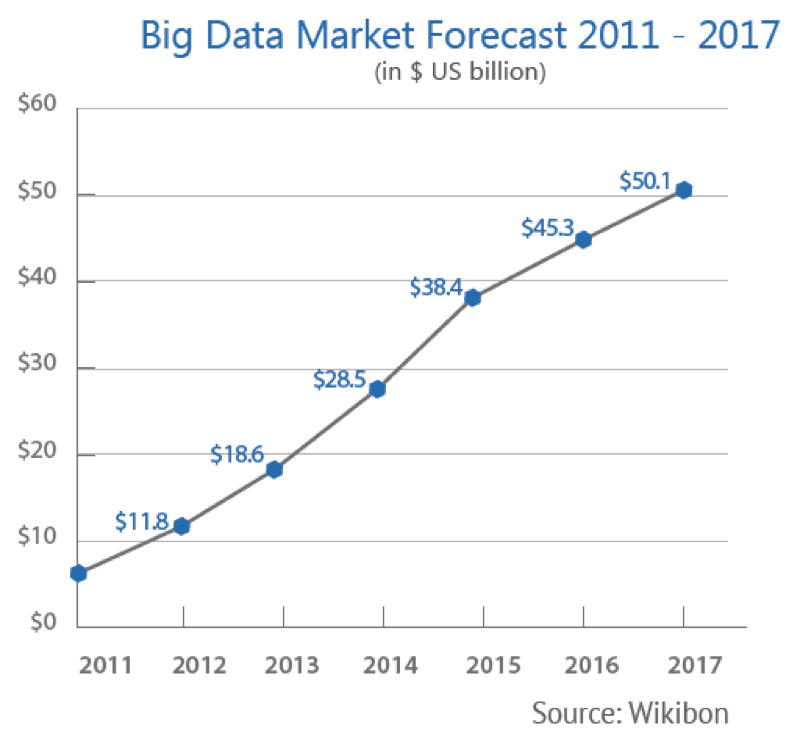 In today’s digital age, most organizations are aware of the multitude of benefits that analytics has to offer, including enhanced decision-making, increased customer satisfaction and retention, decreased operational expenditure, reduced risk and fraud, etc. According to IDC, the global big data and business analytics market was valued at $122 billion in 2015 and will likely reach $187 billion in 2019. The figure below illustrates the tremendous growth of the big data segment alone.
In today’s digital age, most organizations are aware of the multitude of benefits that analytics has to offer, including enhanced decision-making, increased customer satisfaction and retention, decreased operational expenditure, reduced risk and fraud, etc. According to IDC, the global big data and business analytics market was valued at $122 billion in 2015 and will likely reach $187 billion in 2019. The figure below illustrates the tremendous growth of the big data segment alone.
Clearly, more enterprises worldwide are increasingly adopting big data analytics. However, many enterprises seem to think of analytics as a quick fix for their business needs. This idea is far from the truth; investing in analytics is, in fact, only the beginning of a journey. Achieving business goals with the aid of analytics requires an effective Analytics deployment strategy. Enterprises such as Google, Amazon, Netflix, and Starbucks have been successful in these endeavors and were, therefore, able to establish themselves as juggernauts in their respective domains.
At a recent panel discussion hosted by BRIDGEi2i at CYPHER 2016 (an analytics summit), Soumen De, EGM at General Motors Technical Centre (India), explained the concept of Five I’s that they deployed for defining their analytics journey.
Intention: The application of analytics should be driven by a clear business objective or intent.
Information: Factors such as availability and quality of data should be critical to the strategy. Defining a data collection and storage system is a must.
Insights: Data science capabilities must be leveraged to make sense of the collected data, be it structured or unstructured. This includes developing algorithms and choosing the right tool for text mining, clustering, etc.
Influence: The post-analytics insights should be contextualized with respect to business interests, and the stakeholders must be influenced into acting upon the insights.
Initiative: All the efforts should converge on the action: making the right business decisions for achieving business objectives.
This five I’s framework maybe unique to GM India but it is crucial for businesses to build their own blueprint for an analytics first culture, one where data and analytics drive business strategies and decision-making for the organization. This thought process is what separates data-driven organizations, such as Google, Amazon, Netflix, and Starbucks, from others.
Analytics First Culture
Organizations that have successfully formulated the right analytics approach not only realize significant ROI from analytics investments but also witness sustained business growth. Achieving the desired business results has allowed these organizations to expand their analytics footprint to facilitate a wide array of business undertakings. They have evolved into organizations that don’t just deploy analytics as a strategy but use analytics to drive strategy. Once you reach that stage, analytics becomes pervasive and you start to see incremental value across the board. This is the basis of an analytics first culture.
— USE CASE: Let’s take Starbucks as an example. Starbucks is the largest coffee chain in the world with net revenues of more than $16 billion. The company has been quite vocal about the widespread use of analytics across its business operations, and the results are for everyone to see. Starbucks employs big data analytics right from understanding customer preferences to determining the best locations for new stores.
To elaborate further, let us consider one of its star locations as an example – Harvard Square. Starbucks opened four stores at this location within a one-mile radius. Logic would have one believe that this will hurt the profits of the individual stores due to self-cannibalization. However, Starbucks used analytics insights to determine the optimal store locations and customized the menu offerings of each store. End result? Each of these stores is bustling with customers and more dollars in the balance sheet. This is how analytics first organizations stand out. They don’t use analytics as needed; analytics is integral to everything they do as a company.
We have established the premise that fostering an analytics-first culture has significant benefits. However, it comes with its own set of challenges. Most enterprises today have deployed analytics to some extent but the real problem lies in adoption. Without a clear analytics strategy, users don’t see a purpose and that’s a surefire recipe for failure. The problem then compounds to a perceived lack of value from analytics and difficult questions related to analytics RoI. There are a number of organizations that lose their way despite investing heavily in analytics. This eventually leads to downsizing of analytics investments and using analytics reactively as a rear view mirror (historical data analysis).
Coming to solving this puzzle; how should organizations approach building an Analytics First philosophy? While there could be many nuances based on industry type, operating model, customer lifecycle and so on, the common thread is the importance of adopting a deployment model that will ensure sustained value from Analytics.
Analytics Deployment Models
Enterprises need to get past discussions pertaining to how important analytics is for achieving business objectives. Instead, the focus needs to be on how value can be generated from analytics deployment. BRIDGEi2i’s whitepaper The Last Mile of Analytics outlines value generation from analytics in great detail. Deployment models have evolved significantly over the past decade from business process outsourcing days to knowledge process outsourcing to present day hybrid models.
Some of the traditional deployment models are:
Centralized: A single central unit with a resource pool that caters to the needs of all departments
De-centralized: A dedicated unit for each department
Functional: A dedicated unit for functions with unique needs
With evolving business dynamics and technology taking center stage, successful companies like Amazon and Google have redefined the approach and adopted “the hybrid deployment model”. The hybrid deployment model brings the right mix of services, capabilities and technology enablement for enterprises.
Refer to the complete paper here:
The thought paper was extensively discussed at recently concluded Cypher 2016. Here are the videos for that panel discussion:




















































































